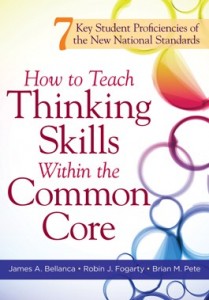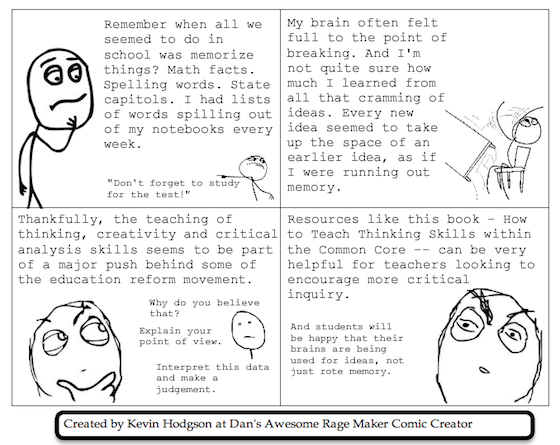Too Complex for the Classroom?
How to Teach Thinking Skills Within the Common Core: Seven Student Proficiencies of the New National Standards
By James A. Bellanca, Robin J. Fogarty, and Brian M. Pete
(Solution Tree Press, 2012 – Learn more)
Given the topic, I realize how ironic this opening statement will be, but How to Teach Thinking Skills Within the Common Core may be just a bit too complicated from a structural standpoint to be a valuable everyday resource to the classroom educator.
This comprehensive examination of nurturing complex, critical thinking skills in our students has a lot of great information and resources within it. However, the problem for me as a reader as I eagerly dove into How to Teach Thinking Skills Within the Common Core is that the book is packed beyond the breaking point with information.
The text is divided into multiple sections, and then split into further subsections, and then subdivided further into teaching and learning strategies within those subsections, complete with changing acronyms (all useful, by the way) and more. It just got too confusing for me as a reader at a certain point.
I found myself stopping often, lost in this rabbit hole of ideas, and wondering if I was now in the section around complex thinking, critical thinking, or creative thinking, or somewhere else. It also occurred me very early that How to Teach Thinking Skills Within the Common Core would have been so much better as an interactive, hyperlinked ebook instead of this paper format.
Down the rabbit hole

- Critical Thinking
- Creative Thinking
- Complex Thinking
- Comprehensive Thinking
- Collaborative Thinking
- Communicative Thinking
- Cognitive Thinking
Each of these main topics is broken down further into subsections of cognitive skills, so that, for example, under Collaborative Thinking, you have chapters on:
- Explain
- Develop
- Decide
And each of those chapters is further broken down into teaching strategies:
- Explicit teaching lesson
- Classroom content lesson
- Common Core Performance Task lesson
- Reflection questions
And each of those sections is broken down even further, so, for example, the explicit teaching area (which they also call the “talk through” area) includes:
- Motivational Mindset
- Order of Operations (and every Order of Operations in the book has its own acronym concept, such as PART and SOLVE and SPARK)
- Instructional Strategy
- Assessment
- Metacognition Reflection
Plenty to admire
There is plenty to admire about this book, including its underlying philosophical stance that rote learning and memorization that has come to characterize much of the learning in classrooms does not produce the kind of thinking, problem-solving citizens that the world will need. And in order to help students navigate through a world that requires critical thinking, we teachers need to be developing activities and projects and sparking discussions that will provide a path for those skills with a mix of explicit instruction, guided discussions and authentic assessments.

The book contains many useful activities and ideas that can help push students as thinkers beyond rote learning. I particularly liked the sections on creative thinking and collaborative thinking. The ideas there have me, well, thinking. As with most Solution Tree Press books, a companion website contains valuable (and free) handouts and referenced materials from in the book.
Common Core aspects
As the title suggests, the authors also explicitly connect the lessons and ideas to the new Common Core English Language Arts standards, showing how critical thinking strategies align nicely with many of the anchor standards and strands of the Common Core.
While some in the teaching world have found the Common Core shifts to be stifling, I am in agreement with the authors of this book that there are plenty of openings in the Common Core for teaching high-order thinking and strategies in the classroom. I also found it helpful that in the sections where the authors provide examples of activities in the classroom, they break them down into elementary, middle and high school levels.
Kevin Hodgson is a sixth grade teacher in Southampton, Massachusetts, and is the technology liaison with the Western Massachusetts Writing Project. Kevin blogs regularly at Kevin’s Meandering Mind and tweets more often than is healthy under his @dogtrax handle.



































I was concluding recently that certain blind spots in our intuition keep us from seeing why higher order thinking skills and their pinnacle in creativity are so powerful and relevant to hyperactive digital 21st century life. I found that conclusion resonating with Albert Bartlett’s thinking about ignorance of the exponential as a great cultural failing. In developing such understanding I see motivation and means to get past such blind spots, and to work thru the complexities: http://ecrop.blogspot.com/2014/01/at-heart-of-creativity.html